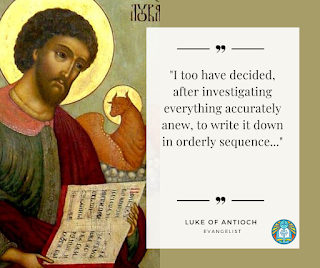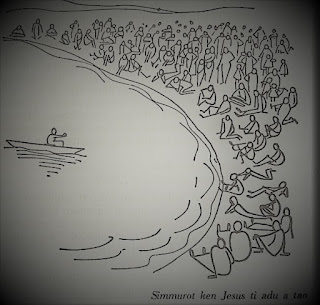Theology of Luke and Mission - Notes
Notes of Fr. Randy Flores, SVD on the theology of Luke and mission
1. Mission and the Lucan Kerygma
Kerygma is the proclamation of Jesus Christ, crucified and risen, as God’s eschatological act of salvation (definition based on Bultmann). Kerygma begins the theology of the New Testament. It has two dimensions: 1. Kerygma as the Act of Proclamation; and 2. Kerygma as What is Proclaimed.
Kerygma as the Act of Proclamation:
As an Act of Proclamation (no. 1) – it is done in three ways: by Jesus (cf. Luke 4:14b-15); by the disciples (must preach with boldness or PARRHESIA in Acts 4:13); and by Luke the Evangelist himself (cf. Acts 1:1 = Luke is a preacher more than a historian).
Kerygma as What Is Proclaimed:
What is proclaimed is not the church, not even ethics, but Jesus Christ. It is also done in three ways:
--by Jesus Christ: see Luke 4:43. The kingdom came with the kerygma. “The kingdom of God is among you” (ENTOS HYMŌN, 17:21). Jesus is the kingdom-preacher as well as salvation-preacher par excellence: Today, salvation [SOTERIA] has come to his house” (Luke 19:9).
--by the disciples: they too preached (a) the kingdom of God (Luke 9:2); (b) the “word of God”—the expression for the Christian Kerygma (Acts 1:3); and (c) Jesus Christ or the CHRIST-EVENT (cf. Acts 28:31).
--by Luke: The age of fulfillment has dawned. It has taken place in the ministry, death, and resurrection of Jesus. At the resurrection, Jesus has been exalted at God’s right hand as the messianic leader of New Israel, and the Spirit in the community is the sign of Christ’s present power and glory. The messianic age will shortly reach its consummation in the return of Christ. Repent, therefore, and be converted (cf. the SPEECH of Peter in Acts 2).
2. The Literary Structure of the Lucan Gospel
--lacks the pedagogical structure of Matthew (cf. Five Discourses) and the symbolic structure of John’s Gospel (Book of Signs—Book of Glory; and Replacement Motif).
--fundamentally followed Mark, but went beyond Mark as well:
.example 1: Infancy Narrative = Jesus is Savior, Messiah, and Lord
.example 2: Travel Narrative (9:51 – 19:27 = ten chapters!). In 9:9, Herod asks: WHO IS THIS? The Travel Narrative is an extensive answer to this Christological question.
3. The Lucan Geographical Perspective and Mission
-- a theological geography
--“When the days drew near for him to be taken up [ANALEMPSIS], he set his face to go to Jerusalem” (Luke 9:51).
-- Prominence of Jerusalem as the city of destiny for Jesus and the pivot for the salvation of humanity
--Jerusalem is the city of the One Who Is to Come (HO ERCHOMENOS) (cf. Luke 19:38).
--God’s salvation begins and ends in Jerusalem (Gospel of Luke) and from Jerusalem to the end of the earth (Acts).
“and that repentance and forgiveness of sins are to be proclaimed in his name to all nations, beginning from Jerusalem” (Luke 24:47).
--WORD OF GOD (=Kerygma) – its movement: From Jerusalem to Outer Judea, Samaria, Caesarea Maritima, Galilee, Damascus, Phoenicia, Cyprus, Syria, Antioch, Roman Provinces of Cilicia, Galatia, Asia, Macedonia, Achaia, and finally ROME, “the end of the earth.”
4. The Lucan Historical Perspective and Mission
Luke’s Concern to Situate the Christ-event in Time
-- Christ-event is related to persons, times, institutions, and epochs of world history
--the story of Jesus is related by Luke to world history in three ways: Roman history (cf. decree of Caesar Augustus), Jewish history (cf. King Herod), and church history (cf. Acts)
Salvation-History
--the entrance of salvation in history
-- the divine “plan” for the salvation of humanity; called also “God’s design” (HE BOLUE TOU THEOU in Luke 7:30)
---Luke calls the execution or realization of the plan “fulfillment” (PLĒROŌ in Luke 4:21)
--Phases or Stages of Lucan Salvation-History:
a. Period of Israel, from creation to the appearance of John the Baptist: the period of the law and the prophets
b. Period of Jesus, from the baptism of John to the ascension of Jesus: The period of Jesus’ ministry, death, and exaltation
c. Period of the Church, from Jesus’ ascension to this Parousia: The period of the spread of the word of God.




Comments
Post a Comment